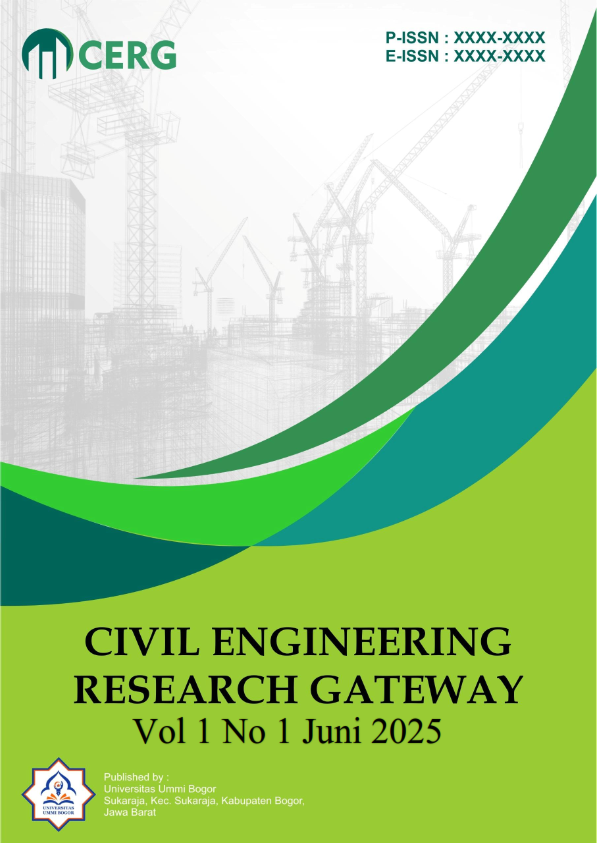Emerging Trends in Civil Engineering: Structural Safety, Sustainability, and Technological Integration
Keywords:
Building Information Modeling, Civil Engineering, Structural Safety, Sustainability, Technological IntegrationAbstract
Civil engineering as a discipline is currently experiencing a profound transformation driven by the need to address increasingly complex infrastructure challenges in a rapidly changing world. Population growth, urbanization, and climate change have created unprecedented demands on infrastructure systems, requiring engineers to design structures that are not only safe and durable but also sustainable and adaptive. Against this backdrop, the objective of this study is to examine emerging trends in civil engineering with particular emphasis on three interconnected pillars: structural safety, sustainability, and technological integration. Methodologically, this research is grounded in a qualitative review and conceptual synthesis of current practices and innovations, drawing insights from the implementation of advanced safety standards, the application of sustainable materials and methods, and the adoption of cutting-edge digital technologies. The findings reveal that structural safety remains the foundation of civil engineering practice, but the definition of safety is broadening to encompass resilience against natural disasters, adaptability to uncertain environmental conditions, and the ability to extend service life while reducing maintenance costs. Sustainability is identified as a parallel and equally critical focus, encouraging the use of renewable resources, circular construction practices, and designs that minimize ecological impact without compromising functionality. Technological integration, particularly through Building Information Modeling (BIM), Geographic Information Systems (GIS), and smart sensor networks, has emerged as a catalyst that unites safety and sustainability by enabling predictive analysis, real-time monitoring, and improved project collaboration. The results suggest that future civil engineering will increasingly rely on a multidisciplinary perspective, where engineers must combine technical expertise with environmental awareness and digital literacy. The implications are significant for both theory and practice, indicating that the profession is moving toward a paradigm where structural reliability, ecological responsibility, and technological innovation coexist as inseparable priorities. Ultimately, embracing these trends offers a pathway to creating infrastructures that not only meet immediate societal needs but also contribute to long-term global resilience and sustainable development..
References
Asian Development Bank (ADB). (2021). Asian infrastructure needs report. ADB Publications.
Azhar, S. (2011). Building Information Modeling (BIM): Trends, benefits, risks, and challenges for the AEC industry. Leadership and Management in Engineering, 11(3), 241–252. https://doi.org/10.1061/(ASCE)LM.1943-5630.0000127
Byrne, B. M. (2016). Structural equation modeling with AMOS: Basic concepts, applications, and programming (3rd ed.). Routledge.
Creswell, J. W., & Creswell, J. D. (2018). Research design: Qualitative, quantitative, and mixed methods approaches (5th ed.). Sage Publications.
Darko, A., & Chan, A. P. C. (2018). Review of barriers to green building adoption. Sustainable Development, 26(6), 694–707. https://doi.org/10.1002/sd.1741
Darko, A., & Chan, A. P. C. (2018). Strategies to promote green building technologies adoption in developing countries: The case of Ghana. Building and Environment, 130, 74–84. https://doi.org/10.1016/j.buildenv.2017.12.022
Durdyev, S., Ismail, S., & Kandymov, N. (2018). Structural equation model of the factors affecting construction labor productivity. Journal of Construction Engineering and Management, 144(4), 04018007. https://doi.org/10.1061/(ASCE)CO.1943-7862.0001452
Elkington, J. (1998). Cannibals with forks: The triple bottom line of 21st century business. Capstone.
Etikan, I., Musa, S. A., & Alkassim, R. S. (2016). Comparison of convenience sampling and purposive sampling. American Journal of Theoretical and Applied Statistics, 5(1), 1–4. https://doi.org/10.11648/j.ajtas.20160501.11
Goh, C. S., & Loosemore, M. (2017). The impacts of industrialization on construction subcontractors: A resource based view. International Journal of Project Management, 35(5), 797–807. https://doi.org/10.1016/j.ijproman.2017.02.016
Hair, J. F., Black, W. C., Babin, B. J., & Anderson, R. E. (2019). Multivariate data analysis (8th ed.). Cengage Learning.
Holling, C. S. (1973). Resilience and stability of ecological systems. Annual Review of Ecology and Systematics, 4(1), 1–23. https://doi.org/10.1146/annurev.es.04.110173.000245
Joshi, A., Kale, S., Chandel, S., & Pal, D. K. (2015). Likert scale: Explored and explained. British Journal of Applied Science & Technology, 7(4), 396–403. https://doi.org/10.9734/BJAST/2015/14975
Lee, D., Kim, S., & Park, M. (2021). Effects of digital transformation on construction safety management. Automation in Construction, 129, 103776. https://doi.org/10.1016/j.autcon.2021.103776
Marzouk, M., & Othman, A. (2017). Planning utility infrastructure requirements for smart cities using BIM and GIS. Automation in Construction, 83, 220–234. https://doi.org/10.1016/j.autcon.2017.08.010
Melchers, R. E., & Beck, A. T. (2018). Structural reliability analysis and prediction (3rd ed.). Wiley.
Mokhlesian, S., & Holmén, M. (2012). Business model changes and green construction: An emerging trend. International Journal of Innovation Management, 16(06), 1240014. https://doi.org/10.1142/S1363919612400140
Opoku, A., & Ahmed, V. (2016). Leadership and sustainability in the built environment. Routledge.
Paton, D., & Buergelt, P. T. (2019). Risk, transformation and adaptation: Ideas for reframing approaches to disaster risk reduction. International Journal of Environmental Research and Public Health, 16(14), 2594. https://doi.org/10.3390/ijerph16142594
Rockström, J., Gupta, J., Lenton, T. M., Qin, D., Lade, S. J., Abrams, J. F., ... & Schellnhuber, H. J. (2020). Identifying a safe and just corridor for people and the planet. Earth’s Future, 8(10), e2020EF001866. https://doi.org/10.1029/2020EF001866
Rogers, E. M. (2003). Diffusion of innovations (5th ed.). Free Press.
Succar, B., & Kassem, M. (2015). Macro-BIM adoption: Conceptual structures. Automation in Construction, 57, 64–79. https://doi.org/10.1016/j.autcon.2015.04.018
Tavakol, M., & Dennick, R. (2011). Making sense of Cronbach’s alpha. International Journal of Medical Education, 2, 53–55. https://doi.org/10.5116/ijme.4dfb.8dfd
Volk, R., Stengel, J., & Schultmann, F. (2019). Building Information Modeling (BIM) for existing buildings—Literature review and future needs. Automation in Construction, 38, 109–127. https://doi.org/10.1016/j.autcon.2013.10.023
WCED (World Commission on Environment and Development). (1987). Our common future. Oxford University Press.
Downloads
Published
Issue
Section
License
Copyright (c) 2025 Civil Engineering Research Gateway

This work is licensed under a Creative Commons Attribution-ShareAlike 4.0 International License.



